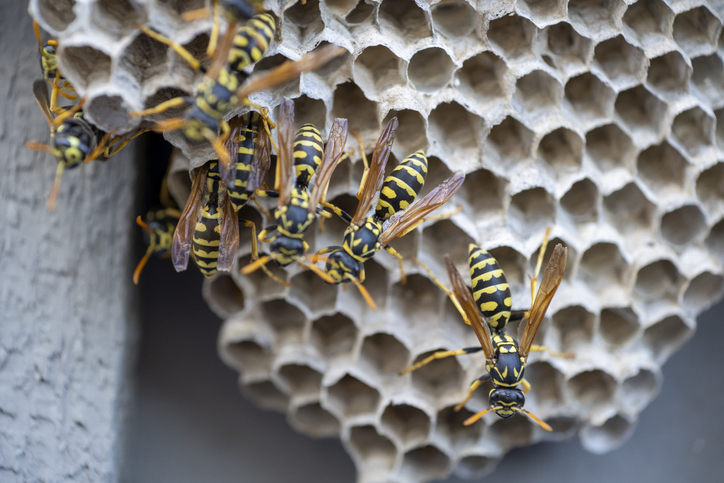How Wasps Construct Their Nests
How Do Wasps Build Their Nests?
Wasps construct their nests using a remarkable process that begins in spring. The queen wasp starts by chewing wood fibers and mixing them with saliva to create a papery pulp. She then forms this into hexagonal cells, laying the foundation of the nest. As the colony grows, worker wasps take over, expanding the nest with more cells and layers to accommodate the increasing population. This intricate process showcases the wasps’ natural architectural skills.
How Wasps Construct Their Nests
Wasps, often seen as unwelcome guests in our gardens and homes, are actually fascinating creatures, especially when it comes to their nest-building abilities. At Orkin, we not only provide solutions to manage these insects but also believe in educating our community about their intriguing behaviors. Let’s dive into the world of wasps and discover how they construct their intricate nests.
The Ingenious Architects: Wasp Nest Construction
The construction of a wasp nest is a marvel of natural engineering, showcasing the wasps’ innate architectural skills. This process begins in the spring, a critical time for the wasp colony. The queen, the sole survivor of the winter, emerges from hibernation to embark on this monumental task. Her first mission is to find a suitable location, which could be in a sheltered spot like under eaves, in attics, or even in the hollows of trees.

Save $50
on your first recurring service today with code GET50
Once the site is selected, the queen starts the construction. She collects wood fibers from various sources, such as fence posts, garden sheds, or dead trees. These fibers are meticulously chewed and mixed with her saliva, a process that transforms them into a malleable, papery pulp. This pulp is the primary building material for the nest.
The queen lays the foundation of the nest by creating a series of cells, each a tiny hexagonal chamber. These cells are masterpieces of efficiency and strength, designed to maximize space and durability. The hexagonal shape is a marvel in itself, providing the strongest structure with the least amount of material. Initially, these cells are used to lay eggs, which the queen tends to diligently.
As the first eggs hatch and the larvae grow, the queen’s role evolves from a builder to a caretaker, feeding and nurturing the young wasps. This early stage of the nest is critical, as it sets the foundation for the colony’s future.

GET A PERSONALIZED QUOTE
To protect your home from pests, click here for a free pest control estimate. Our Orkin Pros will create a personalized pest treatment plan for your home or business
or Call (866) 249-0292
A Growing Home: Expansion of the Nest
As the first brood of worker wasps matures, they take over the nest-building responsibilities, allowing the queen to focus solely on laying eggs. This is when the nest starts to expand significantly. The worker wasps, driven by instinct, continue to gather wood fibers, expanding the nest with more cells, layers, and sometimes even new tiers.
The expansion of the nest is a continuous process throughout the summer. As the colony grows, so does the need for more space. The workers tirelessly add to the nest, ensuring there is enough room for new eggs, larvae, and pupae. The design of the nest, while varying among species, generally follows a pattern of layered combs with protective outer coverings.
Some species of wasps can create nests that house thousands of individuals, with the structure becoming quite large by the end of the summer. The size and complexity of the nest are a testament to the collective effort and coordination of the wasp colony.
Throughout this process, the nest remains a hub of activity, with wasps constantly coming and going, foraging for food, and defending their home. The nest not only serves as a nursery and home for the colony but also as a fortress, protecting the wasps from predators and harsh weather conditions.
In both the initial construction by the queen and the subsequent expansion by the workers, the nest stands as a remarkable example of natural architecture and communal effort. It’s a testament to the wasps’ ability to adapt, survive, and thrive in various environments.
Orkin’s Role in Wasp Management
While admiring the wasps’ architectural prowess, it’s important to remember that they can pose risks, especially when nests are built close to human activity. Orkin specializes in safe, effective wasp management. Our trained professionals can assess the situation and recommend the best course of action, prioritizing your safety and the environment.
Preventive Measures and Solutions
Prevention is key in wasp management. Regularly inspecting your property for early signs of nest building can make a big difference. If you spot a nest, it’s crucial to call Orkin for professional assistance. Attempting to remove a nest on your own can be dangerous.
Orkin’s Expertise: Your Peace of Mind
At Orkin, we understand the importance of addressing wasp issues promptly and efficiently. Our team is equipped with the knowledge and tools to handle wasp nests safely, ensuring your peace of mind. Remember, dealing with wasps is not just about removing nests; it’s about understanding their behavior and taking proactive measures.
Frequently Asked Questions
What materials do wasps use to build their nests?
Wasps use wood fibers mixed with their saliva to create a papery pulp for constructing their nests.
When do wasps typically start building their nests?
Wasps usually begin nest construction in the spring.
Who builds the initial wasp nest?
The queen wasp is responsible for building the initial structure of the nest.
How do wasps design their nests?
Wasps design their nests with hexagonal cells, which provide strength and efficiency in space usage.
What happens to the wasp nest in winter?
Most wasp nests are abandoned in winter, as the colony dies off except for the new queens.
Can wasp nests damage property?
Wasp nests can potentially damage property, especially if built in or on structures like attics or walls.
How large can a wasp nest get?
Some wasp nests can grow very large, housing thousands of wasps by the end of summer.
Do all wasps build nests?
Most social wasps build nests, but solitary wasp species do not.
Conclusion
The construction of wasp nests is a fascinating display of nature’s ingenuity. From the queen laying the foundation to the workers expanding it into a thriving colony, every stage of the process is a testament to the wasps’ architectural prowess and social cooperation. While wasps can be a nuisance and sometimes a danger when their nests are too close to human activity, understanding their nest-building behavior fosters a deeper respect for these creatures and their role in our ecosystem.
At Orkin, we recognize the importance of balancing the need for wasp management with respect for the natural world. Our approach is not just about removing a nuisance but about understanding the behavior of these insects and finding solutions that are safe, effective, and environmentally responsible. Whether you’re dealing with a wasp nest on your property or simply curious about these fascinating creatures, remember that Orkin is here to provide expertise and assistance.

FIND YOUR LOCAL BRANCH
To protect your home from pests, click here for a free pest control estimate. Our Orkin Pros will create a personalized pest treatment plan for your home or business
or Call (866) 249-0292

